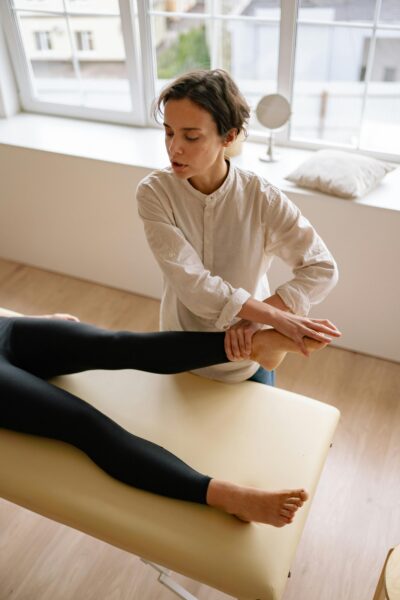Posterior Drawer Test (Ankle)
The Posterior Drawer Test (Ankle) is an orthopedic examination used to assess the stability and integrity of the posterior talofibular ligament (PTFL)—one of the key lateral ligaments of the ankle—and the overall stability of the talocrural (ankle) joint. This test is useful after ankle trauma, particularly in identifying posterior ligament injuries or chronic instability.
How the Test is Performed
-
Client position: Supine with the knee flexed to about 90° and the ankle at 90° (neutral).
-
The examiner stabilizes the anterior tibia with one hand, fingers wrapped around the medial tibia as “sensors.” The other hand cups the heel, fingers around the posterior aspect.
-
Force application: Instead of pulling forward as in the anterior drawer test, the examiner applies a posterior force to the calcaneus and foot while stabilizing the tibia—essentially attempting to push the talus posteriorly relative to the tibia.
-
Positive test: Excessive posterior translation (“laxity”) or a soft/absent end-feel compared to the contralateral side suggests a PTFL injury or generalized ligamentous laxity.
-
Compare both sides for accuracy.
Clinical Significance
-
Positive Posterior Drawer Test: Indicates possible PTFL injury, especially after severe ankle sprain or trauma with forced dorsiflexion/inversion.
-
Useful in cases of chronic ankle instability, multidirectional laxity, or pain at the back/lateral ankle, especially after significant trauma.
-
The test is less commonly positive than the anterior drawer (as PTFL injuries are less common), but important for ruling out more severe injury or instability.
Assessment
-
Use this test in clients with chronic ankle pain, instability after sprain, or symptoms suggesting posterior/lateral ankle involvement.
-
Document differences in posterior movement and end-feel, presence of pain, and functional limitations with gait or activity.
Treatment
-
If positive:
-
Avoid aggressive manual therapy, mobilization, or deep tissue techniques over the posterior/lateral ankle in the acute phase or when instability is present.
-
Focus on gentle soft tissue mobilization for adjacent muscles (peroneals, gastrocnemius, tibialis posterior) and support swelling reduction, proprioceptive work, and strengthening as tolerated.
-
Educate about bracing, taping, and activity modification during healing, with gradual progression as stability improves.
-
Collaborate with physiotherapists for comprehensive rehab, especially for balance/proprioception training and prevention of future instability.
-
Safety and Referral
-
Refer for medical assessment/imaging if instability is marked, there is persistent pain, or suspicion of complex/multiligament injury (especially if normal ankle mechanics are lost or function is severely affected).
-
Monitor for signs of chronic instability and educate clients regarding injury prevention strategies.

